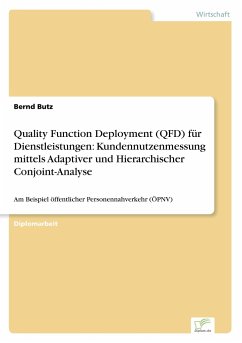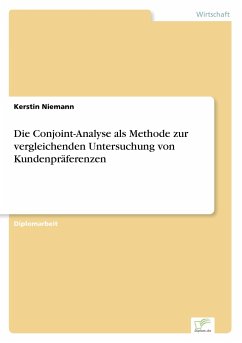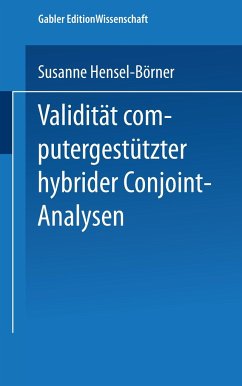Diploma Thesis from the year 1998 in the subject Business economics - Marketing, Corporate Communication, CRM, Market Research, Social Media, grade: 1,0, Karlsruhe Institute of Technology (KIT) (Unbekannt), language: English, abstract: Inhaltsangabe:Zusammenfassung:
Die vorliegende Arbeit (in Englisch) beschäftigt sich mit der Integration der Methodik Conjointanalyse (CA) in den Quality Function Deployment Prozeß, um den QFD-Prozeß in Entscheidungs- und Bewertungssituationen zu unterstützen. Im Mittelpunkt steht dabei die Untersuchung der gängigen Conjointmethoden auf Anwendbarkeit und Eignung für groß angelegte Studien, wie z. B. QFD-Anwendungen. Detailliert wird dabei auf eine Erweiterung oder Unterstützung der Conjointanalyse eingegangen, um eine Vielzahl an Merkmalen und Merkmalsausprägungen (Kundenanforderungen) berücksichtigen zu können.
Die kommerzielle Anwendung der einzelnen Methodiken, eine Fragebogenauswertung sowie ein Vergleich von 21 CA- und 3 der bekanntesten QFD Software-tools runden diese Arbeit ab.
Abstract:
This paper is structured into 5 chapters:
Chapter 1 contains an introduction into the problem area and the aim of the thesis. Moreover, it gives a survey of the procedure to reach the target of extending and supporting several Conjoint Analysis methodologies to be able for an integration into the Quality Function Deployment approach with its huge amount of customer requirements (attributes and levels).
Chapter 2 shows the integration of Conjoint Analysis and Quality Function Deployment into the Total Quality Management concept as quality improving, customer orientated (key word mass customization), and cost reducing tools. The importance to support Quality Function Deployment by Conjoint Analysis is pointed out to lead over to the main chapter of the paper.
Chapter 3 is dedicated to several Conjoint Analysis models and the way in which to extend and support these methods, so that an integration into a large industrial study such as a Quality Function Deployment application can take place without any problems. To this purpose several conjoint techniques are described in detail, are extended by further techniques, and are compared to each other concerning their validity so that, finally, explicit recommendations can be given. The commercial use of Conjoint Analysis and the method transfer into several software-tools round off this chapter.
Chapter 4 describes the Quality Function Deployment methodology in relation to the aim of this paper. The central subject is the House of Quality and its places where the Conjoint Analysis technique(s) can be applied. Results about the commercial use of several software-tools finish this chapter.
Chapter 5 sums up the results and findings of the paper and gives an outlook for further research in that field.
The appendix presents a huge amount of tables, which list and describe in detail available software-tools referring to Conjoint Analysis andQuality Function Deployment. Some screenshots of QFD software-tools are also given.
Inhaltsverzeichnis:Table of Contents:
1.Introduction1
1.1Problem Area and Target1
1.2Proceeding to Reach the Target2
1.3Structure of the Paper3
2.QFD and CA as a Part of the TQM Concept4
2.1The Meaning of Quality5
2.2Customer Orientation9
2.3Customer Satisfaction by Mass Customization13
2.3.1Framework to Effective Mass Customization16
2.3.2The Four Faces to Customization19
2.4Failure Costs21
2.5Supporting QFD through Conjoint Analysis25
2.5.1The Weakness of QFD25
2.5.2Conjoint Analysis: The Way out of the Dilemma27
2.6Summary28
3.Conjoint Analysis: Methods, Extensions, Use29
3.1Methodological Developments in Conjoint Analysis31
3.2Self-Explicated Model (SEM)34
3.2.1Calculating the SEM Part-Worths34
3.2.2Strengths and Weaknesses38
...
Hinweis: Dieser Artikel kann nur an eine deutsche Lieferadresse ausgeliefert werden.
Die vorliegende Arbeit (in Englisch) beschäftigt sich mit der Integration der Methodik Conjointanalyse (CA) in den Quality Function Deployment Prozeß, um den QFD-Prozeß in Entscheidungs- und Bewertungssituationen zu unterstützen. Im Mittelpunkt steht dabei die Untersuchung der gängigen Conjointmethoden auf Anwendbarkeit und Eignung für groß angelegte Studien, wie z. B. QFD-Anwendungen. Detailliert wird dabei auf eine Erweiterung oder Unterstützung der Conjointanalyse eingegangen, um eine Vielzahl an Merkmalen und Merkmalsausprägungen (Kundenanforderungen) berücksichtigen zu können.
Die kommerzielle Anwendung der einzelnen Methodiken, eine Fragebogenauswertung sowie ein Vergleich von 21 CA- und 3 der bekanntesten QFD Software-tools runden diese Arbeit ab.
Abstract:
This paper is structured into 5 chapters:
Chapter 1 contains an introduction into the problem area and the aim of the thesis. Moreover, it gives a survey of the procedure to reach the target of extending and supporting several Conjoint Analysis methodologies to be able for an integration into the Quality Function Deployment approach with its huge amount of customer requirements (attributes and levels).
Chapter 2 shows the integration of Conjoint Analysis and Quality Function Deployment into the Total Quality Management concept as quality improving, customer orientated (key word mass customization), and cost reducing tools. The importance to support Quality Function Deployment by Conjoint Analysis is pointed out to lead over to the main chapter of the paper.
Chapter 3 is dedicated to several Conjoint Analysis models and the way in which to extend and support these methods, so that an integration into a large industrial study such as a Quality Function Deployment application can take place without any problems. To this purpose several conjoint techniques are described in detail, are extended by further techniques, and are compared to each other concerning their validity so that, finally, explicit recommendations can be given. The commercial use of Conjoint Analysis and the method transfer into several software-tools round off this chapter.
Chapter 4 describes the Quality Function Deployment methodology in relation to the aim of this paper. The central subject is the House of Quality and its places where the Conjoint Analysis technique(s) can be applied. Results about the commercial use of several software-tools finish this chapter.
Chapter 5 sums up the results and findings of the paper and gives an outlook for further research in that field.
The appendix presents a huge amount of tables, which list and describe in detail available software-tools referring to Conjoint Analysis andQuality Function Deployment. Some screenshots of QFD software-tools are also given.
Inhaltsverzeichnis:Table of Contents:
1.Introduction1
1.1Problem Area and Target1
1.2Proceeding to Reach the Target2
1.3Structure of the Paper3
2.QFD and CA as a Part of the TQM Concept4
2.1The Meaning of Quality5
2.2Customer Orientation9
2.3Customer Satisfaction by Mass Customization13
2.3.1Framework to Effective Mass Customization16
2.3.2The Four Faces to Customization19
2.4Failure Costs21
2.5Supporting QFD through Conjoint Analysis25
2.5.1The Weakness of QFD25
2.5.2Conjoint Analysis: The Way out of the Dilemma27
2.6Summary28
3.Conjoint Analysis: Methods, Extensions, Use29
3.1Methodological Developments in Conjoint Analysis31
3.2Self-Explicated Model (SEM)34
3.2.1Calculating the SEM Part-Worths34
3.2.2Strengths and Weaknesses38
...
Hinweis: Dieser Artikel kann nur an eine deutsche Lieferadresse ausgeliefert werden.








